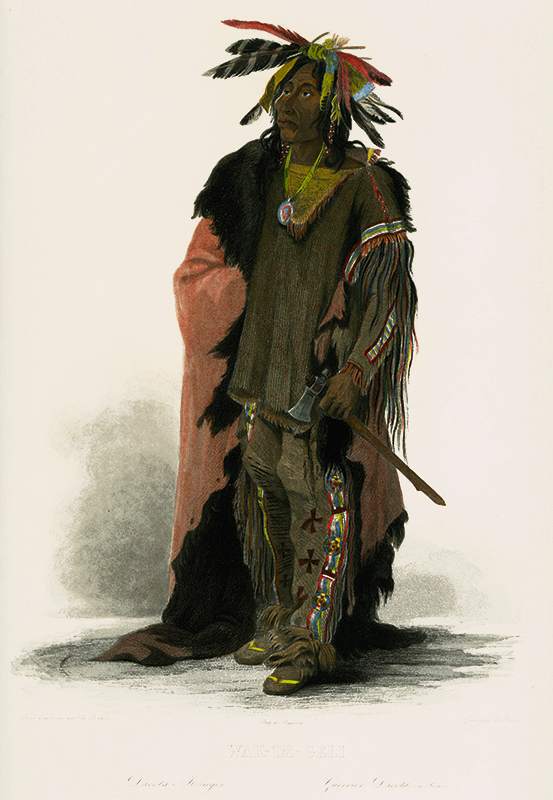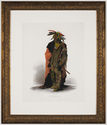
19th, 20th & 21st Century Fine Prints
707-546-7352 · fax 707-546-7924 · web: www.annexgalleries.com · email: artannex@aol.com
Wak-Tae-Geli, A Sioux Warrior (Wahk-Ta-Ge-Li) by Karl Bodmer



Wak-Tae-Geli, A Sioux Warrior (Wahk-Ta-Ge-Li)
Karl Bodmer
Wak-Tae-Geli, A Sioux Warrior (Wahk-Ta-Ge-Li)
Karl Bodmer
1809 - 1893 (biography)From the portfolio “Travels in the Interior of North America Between 1832 and 1834” by Prince Maximilian of Weid, Germany, after Bodmer's watercolors.The portfolio consisted of 48 folio size and 31 vignettes. Originally titled in German, French (as this) and English. There is a blindstamp: “C. Bodmer/Direct”.
This is a fine full-length portrait carried out by Bodmer at the Sioux agency in the Dakotas in May 1833: both the pose and the attitude of the subject are reminiscent of numerous portraits of European nobility, and with good reason: Wahk-Tä-ge-Li was a six foot six inch Yankton Sioux chief, a man of power and substance. His Sioux name meant 'Gallant Warrior' and he was known to the Americans as `Big Soldier'.
He was about sixty years old at the time of his portrait, and is shown wearing moccasins, leggings, and shirt embroidered with band of brightly dyed porcupine quills. The fringe on the shirtsleeve is human hair from a Mandan foe. The feathers bound to his head represent enemies slain in battle. In his ears he wear long strings of blue glass beads, and around his neck hangs a large peace medal presented by the government. His robe is tanned to an unusual whiteness and in his hand is the pipe-tomahawk that he would smoke occasionally during the two days he posed for Bodmer.
Johann Karl Bodmer was born in Zurich, Switzerland on 11 February 1809. He was a Swiss and French citizen and his name was recorded both as Johann Karl Bodmer and Jean-Charles Bodmer. When Bodmer was thirteen years of age, his uncle, Johann Jakob Meier, a prominent engraver and watercolorist, became his teacher and he took the young lad and his younger brother on artistic travels throughout Switzerland.
Bodmer left Switzerland for Germany in 1828 to work as a painter and engraver in Koblenz. It was during this period that his work caught the attention of Prince Maximilian of Wied, an aristocrat and adventurer. Bodmer accepted the invitation of Prince Maximilian to join his scientific journey through North America as the expedition’s artist. They departed for North America on 17 May 1832 and, in April 1833, they set off from St. Louis, traveling via steam and keelboat up the Missouri River through what is now Missouri, Nebraska, South Dakota, North Dakota, and Montana. They spent the winter in Fort McKenzie before heading downstream. Bodmer created about 400 watercolors of the American Indian tribes, capturing their ceremonies and daily life, and the varying landscapes of North America.
Bodmer returned to Paris and arranged to have eighty-two of his watercolors translated into color aquatints for the book Maxmillian, Prince of Wied’s Travels in the Interior of North America, during the years 1832-34. The book was first published in Koblenz, Germany in two volumes between 1839 and 1841. The English translation was published in London, also in two volumes, between 1843 and 1844.



